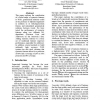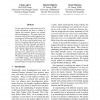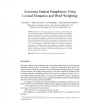126 search results - page 18 / 26 » Unsupervised word sense disambiguation using WordNet relativ... |
COLING
2002
13 years 7 months ago
2002
This paper explores the contribution of a broad range of syntactic features to WSD: grammatical relations coded as the presence of adjuncts/arguments in isolation or as subcategor...
ACL
2008
13 years 8 months ago
2008
To date, parsers have made limited use of semantic information, but there is evidence to suggest that semantic features can enhance parse disambiguation. This paper shows that sem...
ACL
1996
13 years 8 months ago
1996
In this paper, we present a new approach for word sense disambiguation (WSD) using an exemplar-based learning algorithm. This approach integrates a diverse set of knowledge source...
SEMCO
2009
IEEE
14 years 2 months ago
2009
IEEE
In this paper an approach based on Wikipedia link structure for sense disambiguation is presented and evaluated. Wikipedia is used as a reference to obtain lexicographic relations...
AIED
2009
Springer
14 years 2 months ago
2009
Springer
We present in this paper an approach to assessing student paraphrases in the intelligent tutoring system iSTART. The approach is based on measuring the semantic similarity between ...



